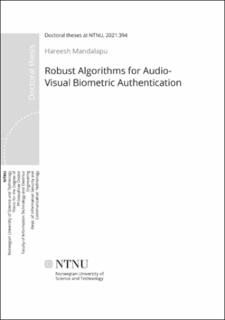| dc.contributor.advisor | Ramachandra, Raghavendra | |
| dc.contributor.advisor | Busch, Christoph | |
| dc.contributor.author | Mandalapu, Hareesh | |
| dc.date.accessioned | 2021-12-15T13:43:50Z | |
| dc.date.available | 2021-12-15T13:43:50Z | |
| dc.date.issued | 2021 | |
| dc.identifier.isbn | 978-82-326-5792-6 | |
| dc.identifier.issn | 2703-8084 | |
| dc.identifier.uri | https://hdl.handle.net/11250/2834504 | |
| dc.description.abstract | Biometric authentication has been a vital method of human identification across a wide range of applications. It is a quick and secure authorization process in applications such as border control and banking transactions. Recent advances in technology have triggered the use of embedded biometrics in smartphones and handheld devices. For reliable authentication, biometrics perform better when compared to traditional techniques such as passwords. Moreover, its advantages, such as permanence and uniqueness, have increased the growth of biometrics in everyday usage. However, there are certain limitations to biometric systems in providing optimal performance. These limitations play a crucial role in formulating artefacts to conceal or recreate the identity of individuals. Therefore, this raises concerns about the robustness of a biometric system and questions the accuracy of biometric recognition. In a real-world scenario, an end-user biometric system is protected from tampering by external sources. However, the only source of interaction is through the data capturing sensor. Thus, external artefacts, namely presentation attacks, have been a severe threat to biometric systems. On the other hand, the internal dependencies typically come from the limitations of the hardware and software deployed in the biometric verification workflow. Examples of internal dependencies vary from noise in biometric data to dependencies of biometric algorithms.
In this thesis, we have focused on improving the generalization of biometrics by working on some of the problems caused by presentation attacks and internal dependencies in biometrics. The key challenges in audio-visual biometrics were identified, and research objectives were designed for this thesis. The vulnerabilities in audio-visual biometrics are observed with the help of a thorough review of existing recognition and presentation attack detection methods. An exhaustive and comprehensive study along with a comparison and categorization of state-of-the-art methods have resulted in a novel dataset. The dataset includes different attributes, which provide the scope to perform extensive experiments to understand dependencies and vulnerabilities. The thesis proposes a fusion of texture features based iris presentation attack detection algorithm, with results showing superior performance. Further, the cross-dataset experiments led to an empirical evaluation of vulnerabilities in iris biometrics due to presentation attacks.
In speaker recognition research, voice impersonation, language dependency and audio replay attacks cause high vulnerability. This thesis proposes a novel voice impersonation dataset with three different languages. The impact of voice impersonation as an attack is evaluated on the state-of-the-art speaker verification methods. Further, the speaker’s language mismatch in the enrollment and testing steps of speaker verification is examined. The recent progress in smartphone usage is also reflected in high-quality speakers and microphones. A replay attack dataset is created with multiple smartphones as playback and recording devices, and vulnerability is examined.
The thesis examines the generalizability of biometric algorithms to improve the robustness of biometric recognition. The results from the proposed methods are evaluated with extensive experiments and detailed examinations of both publicly available databases and new datasets created in this work. In conclusion, the thesis proposes novel methods and approaches to examining the vulnerabilities in audio-visual biometrics, presentation attack detection (PAD) in iris and voice biometrics, the study of language dependency and audio replay attacks. The methods presented are valuable contributions to the research fields in developing robust smartphone biometric methods by addressing vulnerabilities from multiple sources. | en_US |
| dc.language.iso | eng | en_US |
| dc.publisher | NTNU | en_US |
| dc.relation.ispartofseries | Doctoral theses at NTNU;2021:394 | |
| dc.relation.haspart | Paper 1: Mandalapu, Hareesh; Reddy P N, Aravinda; Krothapalli Sreenivasa; Mitra, Pabitra; PrRamachandra, Raghavendra; Rao,asanna, S. R. Mahadeva; Busch, Christoph. Audio-Visual Biometric Recognition and Presentation Attack Detection: A Comprehensive Survey. IEEE Access 2021 ;Volum 9. s. 37431-37455 https://doi.org/10.1109/ACCESS.2021.3063031 (CC BY 4.0) | en_US |
| dc.relation.haspart | Paper 2:
Mandalapu, Hareesh;Reddy P N, Aravinda; Ramachandra, Raghavend; Rao, Krothapalli Sreenivasa; Mitra, Pabitra; Prasanna, S. R. Mahadeva; Busch, Christoph.
Multilingual Audio-Visual Smartphone Dataset And Evaluation. IEEE Access,
https://doi.org/10.1109/ACCESS.2021.3125485
(CC BY 4.0) | en_US |
| dc.relation.haspart | Paper 3: Mandalapu, Hareesh; Ramachandra, Raghavendra; Busch, Christoph. Image Quality and Texture-Based Features for Reliable Textured Contact Lens Detection. I: 14th International Conference on Signal-Image Technology & Internet-Based Systems. IEEE conference proceedings 2019 ISBN 978-1-5386-9385-8. s. 587-594 https://doi.org/10.1109/SITIS.2018.00095 | en_US |
| dc.relation.haspart | Paper 4: Mandalapu, Hareesh; Ramachandra, Raghavendra; Busch, Christoph. Empirical Evaluation of Texture-Based Print and Contact Lens Iris Presentation Attack Detection Methods. I: Proceedings of the 2019 International Conference on Biometric Engineering and Applications (ICBEA 2019). Association for Computing Machinery (ACM) 2019 ISBN 978-1-4503-6305-1. s. 7-14 https://doi.org/10.1145/3345336.3345341
© ACM 2019. This is the author's version of the work. It is posted here for your personal use. Not for redistribution. The definitive Version of Record was published in ICBEA 2019 | en_US |
| dc.relation.haspart | Paper 5: Mandalapu, Hareesh; Busch, Christoph; Ramachandra, Raghavendra. Multilingual Voice Impersonation Dataset and Evaluation. I: Proceeding of the 3rd International Conference on Intelligent Technologies and Applications (INTAP). Springer 2021 ISBN 978-3-030-71711-7. s. 179-188 https://doi.org/10.1007/978-3-030-71711-7_15 | en_US |
| dc.relation.haspart | Paper 6:
Mandalapu, Hareesh; Elbo, Thomas Møller; Ramachandra, Raghavendra; Busch, Christoph.
Cross-lingual Speaker Verification: Evaluation On X-Vector Method. I: Proceeding of the 3rd International Conference on Intelligent Technologies and Applications (INTAP). Springer 2021 ISBN 978-3-030-71711-7. s. 215-226
https://doi.org/10.1007/978-3-030-71711-7_18 | |
| dc.relation.haspart | Paper 7:
Mandalapu, Hareesh;Ramachandra, Raghavendra; Busch, Christoph;
Smartphone Audio Replay Attacks Dataset 2021 IEEE International Workshop on Biometrics and Forensics (IWBF) https://doi.org/ 10.1109/IWBF50991.2021.9465096 | |
| dc.title | Robust Algorithms for Audio-Visual Biometric Authentication | en_US |
| dc.type | Doctoral thesis | en_US |
